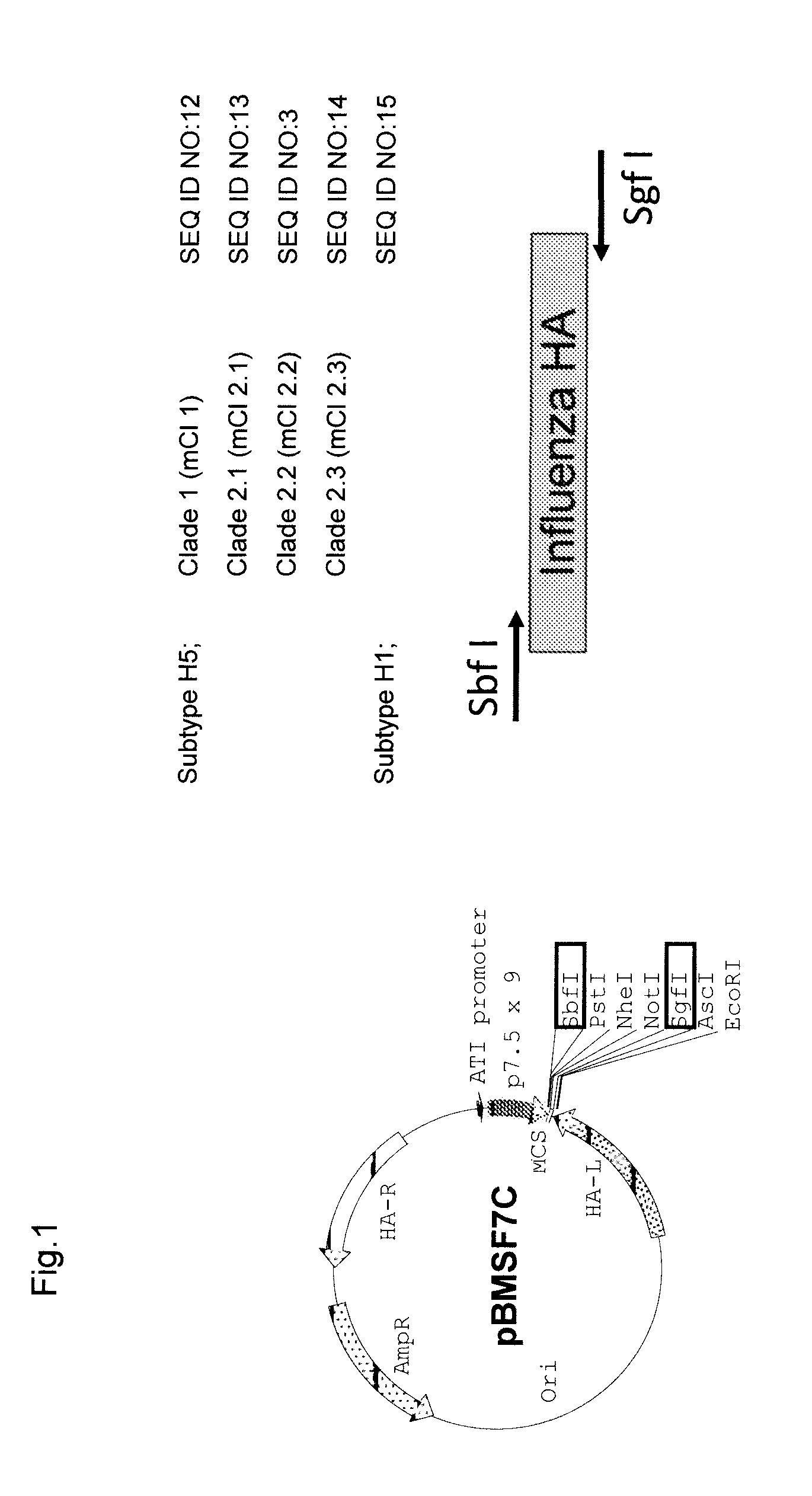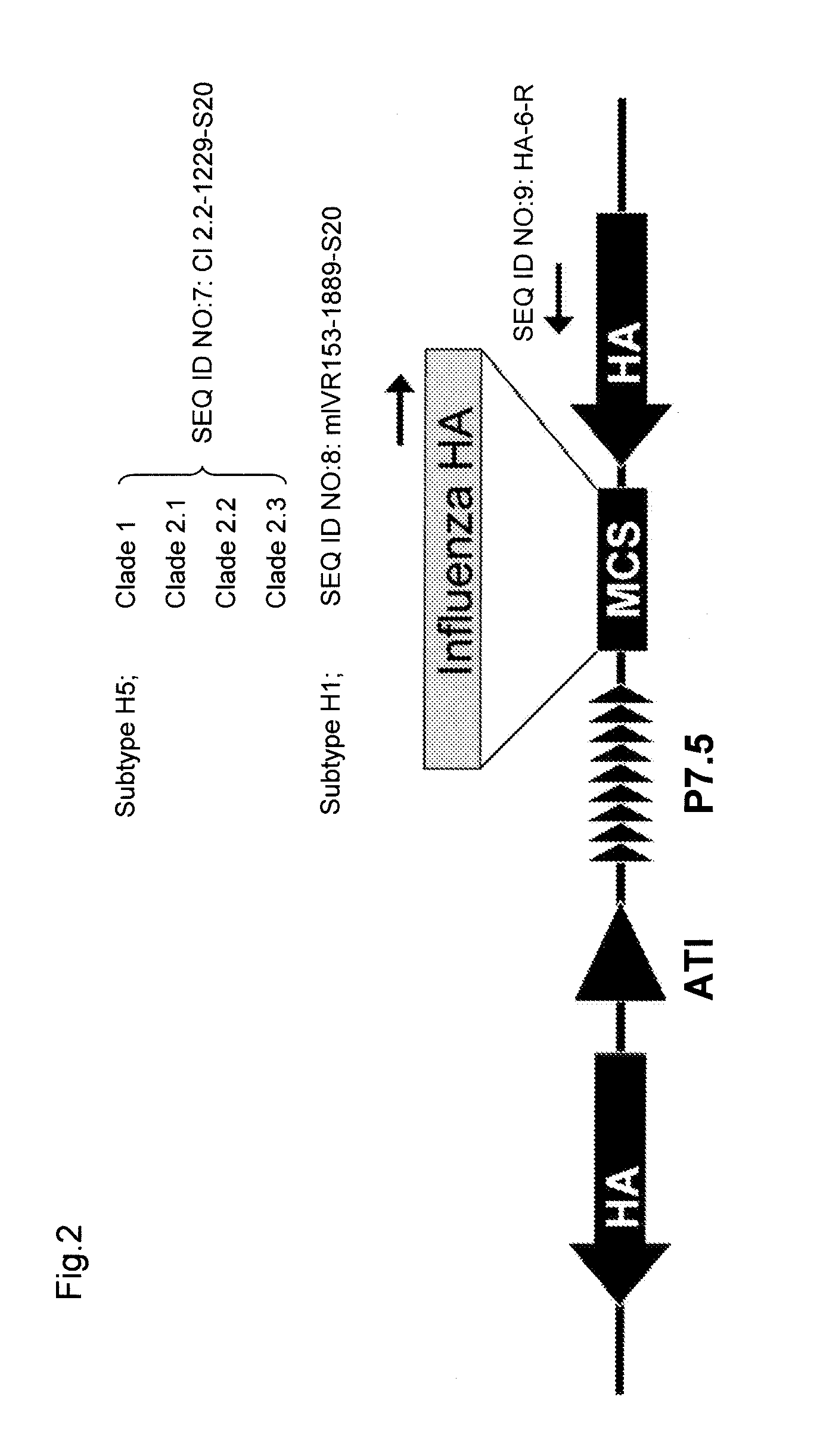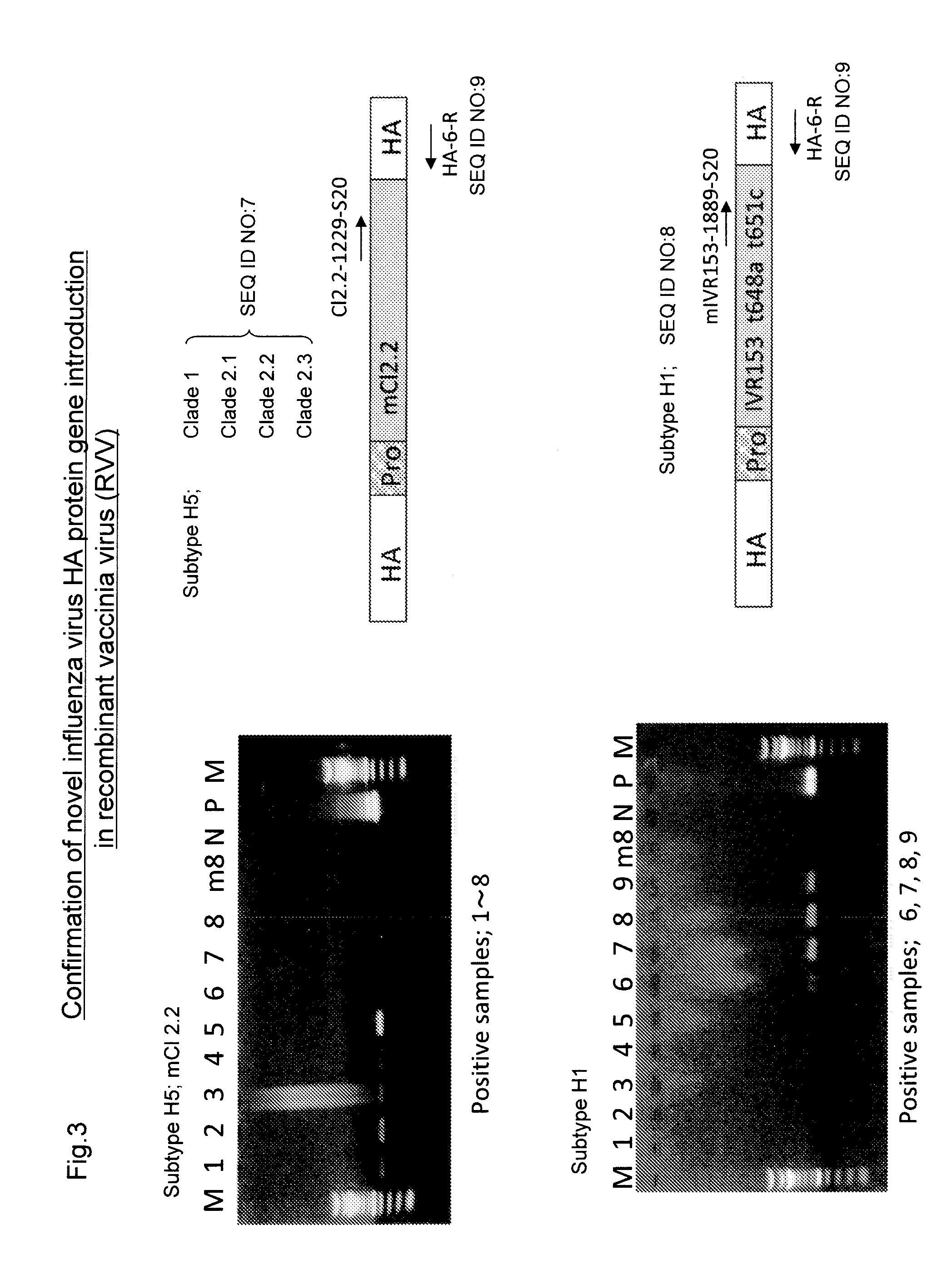Recombinant vaccinia virus having hemagglutinin protein genes derived from novel influenza viruses
a technology of hemagglutinin and vaccinia virus, which is applied in the field of recombinant vaccinia virus having hemagglutinin protein genes derived from novel influenza viruses, can solve the problems that the development of an attenuated vaccine for an emerging virus is known to take a long time, and achieve the effect of inhibiting the onset of symptoms
- Summary
- Abstract
- Description
- Claims
- Application Information
AI Technical Summary
Benefits of technology
Problems solved by technology
Method used
Image
Examples
example 1
Preparation of Recombinant Vaccinia Virus (RVV)
[0079]The HA protein gene of either H5N1 HPAIV (clade 1, clade 2.1, clade 2.2, clade 2.3) or H1N1 (2009) pdm was integrated into the SbfI-SgfI site of pBMSF7C plasmid (see Japanese Laid-Open Patent Application No. 6-237773) so as to prepare plasmid vectors pBMSF7C-mCl1, pBMSF7C-mCl2.1, pBMSF7C-mCl2.2, pBMSF7C-mCl2.3 and pBMSF7C-mIVR153 in which each of the above-mentioned HA protein genes was inserted downstream from the ATI / p7.5hybrid promoter within the hemagglutinin (HA) gene region (FIG. 1). Specifically, DNA having the nucleotide sequence represented by SEQ ID NO:12, as the HA protein gene of clade 1 of H5N1 HPAIV, is inserted into pBMSF7C-mCl1; DNA having the nucleotide sequence represented by SEQ ID NO:13, as the HA protein gene of clade 2.1 of H5N1 HPAIV, is inserted into pBMSF7C-mCl2.1; DNA having the nucleotide sequence represented by SEQ ID NO:3, as the HA protein gene of clade 2.2 of H5N1 HPAIV, is inserted into pBMSF7C-mCl2...
example 2
Confirmation of Introduction of HA Protein Gene by PCR
[0084]PCR was carried out using the following primers specific to each of the HA protein genes (cDNA: SEQ ID NOS:12, 13, 3, 14 and 15) mentioned in Example 1 and the genome of the resulting recombinant vaccinia virus as a template in order to confirm whether each HA protein gene was introduced into the virus genome (FIGS. 2 and 3).
[0085]Nucleotide Sequences of Primers Used in PCR for Confirming Insert
[0086]
[0087]Fw: Cl2.2-1229-S20
5′-CACTCAGTTTGAGGCCGTTG-3′(SEQ ID NO: 7)[0088](for confirming HA protein genes of H5N1 HPAIV (4 types))
[0089]Fw: mIVR153-1889-S20
5′- AATGCGAACTOTTGGTTCT- 3′(SEQ ID NO: 8)[0090](for confirming HA protein gene of H1N1 (2009) pdm)
[0091]
[0092]Rv: HA-6-R
5′- CTAGTTCTGAGAAACCAGAGG-3′(SEQ ID NO: 9)[0093](for confirming HA protein genes of H5N1 HPAIV and H1N1 (2009) pdm)
[0094]Specifically, the composition of the reaction solution was 1 U DNA polymerase, 0.3 mM dNTP, 1 μM F-primer and 1 μM R-primer in 50 μl of a b...
example 3
Confirmation of Expression of HA Protein of H5N1 HPAIV or H1N1 (2009) Pdm by Western Blotting
[0096]The recombinant vaccinia virus was used to infect RK13 cells that had been seeded onto a 6-well plate beforehand at moi=10 and 30° C. for an hour. Following infection, the virus solution was removed by suction and the cells were washed once with PBS(−). To each well, 2 ml of 5% FCS / MEM medium was added for cultivation at 30° C. for 18 hours. 18 hours later, the medium was removed by suction and the cells were washed twice with PBS(−). 100 μl of lysis buffer (1% SDS, 0.5% NP-40, 0.15 M NaCl, 10 mM Tris-HCl (pH 7.4)) was added to lyse the cells, and the solution was transferred into a 1.5 ml Eppendorf tube. The collected solution was subjected to ultrasonication in cold water until zero viscosity. The amount of protein in the prepared solution was quantified according to Lowry method.
[0097]Electrophoresis was carried out for 30 μg of the protein using 10% acrylamide gel. At the end of el...
PUM
| Property | Measurement | Unit |
|---|---|---|
| temperature | aaaaa | aaaaa |
| temperature | aaaaa | aaaaa |
| pH | aaaaa | aaaaa |
Abstract
Description
Claims
Application Information
 Login to View More
Login to View More - R&D
- Intellectual Property
- Life Sciences
- Materials
- Tech Scout
- Unparalleled Data Quality
- Higher Quality Content
- 60% Fewer Hallucinations
Browse by: Latest US Patents, China's latest patents, Technical Efficacy Thesaurus, Application Domain, Technology Topic, Popular Technical Reports.
© 2025 PatSnap. All rights reserved.Legal|Privacy policy|Modern Slavery Act Transparency Statement|Sitemap|About US| Contact US: help@patsnap.com



